Sensitivity Study on the Correlation Level of Seismic Failures in Seismic Probabilistic Safety Assessments
Abstract
:1. Introduction
1.1. Background
1.2. Correlated Seismic Failures and Seismic Common Cause Failures
1.3. Definitions of MUCDF and SCDF
1.4. Original Seismic MUPSA Model (Model A)
1.5. Simplified Seismic MUPSA Model (Model B)
1.6. Objectives of This Study
2. Calculation Model
2.1. SUCDF Fault Trees
2.2. MUCDF Fault Trees
2.3. SCDF Fault Trees
2.4. Seismic Data
3. Seismic Risk Calculation Procedure
3.1. Conversion of Correlated Seismic Failures into Seismic CCFs
3.2. Seismic Risk Calculation
4. Calculation Results
4.1. Calculation Results for SUCCDP and SUCDF
4.2. Calculation Results for MUCCDP and MUCDF
4.3. Calculation Results for SCCDP and SCDF
5. Conclusions
- As the correlation level increased, the seismic risks, i.e., SUCDF, MUCDF, and SCDF, increased for Model A. The seismic risks of Model A were always lower than those of Model B. Therefore, all the seismic risks of Model A can provide a sufficient safety margin for the corresponding safety goals.
- As the correlation level increased, the seismic risks SUCDF and MUCDF of Models A and B increased. Arguably, Models A and B appeared to guarantee conservative seismic SUCDF and MUCDF.
- The SCDF of Model B was strongly distorted in all correlation ranges compared with that of Model A. Therefore, one should be careful to utilize Model B.
Author Contributions
Funding
Institutional Review Board Statement
Informed Consent Statement
Data Availability Statement
Conflicts of Interest
Nomenclature
| CCF | Common cause failure |
| CCDP | Conditional core damage probability |
| SUCCDP | Single-unit CCDP |
| MUCCDP | Multi-unit CCDP |
| SCCDP | Site CCDP |
| CDF | Core damage frequency (initiator frequency × CCDP) |
| SUCDF | Single-unit CDF (seismic initiator frequency × SUCCDP) |
| MUCDF | Multi-unit CDF (seismic initiator frequency × MUCCDP) |
| SCDF | Site CDF (seismic initiator frequency × SCCDP) |
References
- U.S. NRC. Reactor Safety Study. In An Assessment of Accident Risks in U.S. Commercial Nuclear Power Plants; WASH-1400 (NUREG-75/014); US Nuclear Regulatory Commission: Rockville, MD, USA, 1975. [Google Scholar]
- Jung, W.S.; Yang, J.-E.; Ha, J. A new method to evaluate alternate AC power source effects in multi-unit nuclear power plants. Reliab. Eng. Syst. Saf. 2003, 82, 165–172. [Google Scholar] [CrossRef]
- IAEA. The Fukushima Daiichi Accident Report by the Director General; IAEA: Vienna, Austria, 2015. [Google Scholar]
- Fleming, K.; Chan, E.; Dermarkar, F.; Georgescu, G.; Gheorche, R.; Modarres, M.; Rowekamp, M.; Takada, T.; Yalaoui, S. Summary Report of the International Workshop on Multi-unit Probabilistic Safety Assessment; Canadian Nuclear Safety Commission: Ottawa, ON, Canada, 2014. [Google Scholar]
- Schroer, S.; Modarres, M. An event classification schema for evaluating site risk in a multi-unit nuclear power plant probabilistic risk assessment. Reliab. Eng. Syst. Saf. 2013, 117, 40–51. [Google Scholar] [CrossRef]
- Kumar, C.S.; Hassija, V.; Velusamy, K.; Balasubramaniyan, V. Integrated risk assessment for multi-unit NPP sitesda comparison. Nucl. Eng. Des. 2015, 293, 53–62. [Google Scholar] [CrossRef]
- Modarres, M.; Zhou, T.; Massoud, M. Advances in multi-unit nuclear power plant probabilistic risk assessment. Reliab. Eng. Syst. Saf. 2017, 157, 87–100. [Google Scholar] [CrossRef]
- Kim, D.S.; Han, S.H.; Park, J.H.; Lim, H.-G.; Kim, J.H. Multi-unit Level 1 probabilistic safety assessment: Approaches and their application to a six-unit nuclear power plant site. Nucl. Eng. Technol. 2018, 50, 1217–1233. [Google Scholar] [CrossRef]
- Yang, J.E. Multi-unit risk assessment of nuclear power plants: Current status and issues. Nucl. Eng. Technol. 2018, 50, 1199–1209. [Google Scholar] [CrossRef]
- IAEA. Technical Approach to Probabilistic Safety Assessment for Multiple Reactor Units; IAEA: Vienna, Austria, 2019. [Google Scholar]
- Kim, D.S.; Park, J.H.; Lim, H.G. A pragmatic approach to modeling common cause failures in multi-unit PSA for nuclear power plant sites with a large number of units. Reliab. Eng. Syst. Saf. 2020, 195, 106739. [Google Scholar] [CrossRef]
- Jang, S.H.; Jae, M.S. A development of methodology for assessing the inter-unit common cause failure in multi-unit PSA model. Reliab. Eng. Syst. Saf. 2020, 203, 107012. [Google Scholar] [CrossRef]
- Jung, W.S. A method to avoid underestimated risks in seismic SUPSA and MUPSA for nuclear power plants caused by partitioning events. Energies 2021, 14, 2150. [Google Scholar] [CrossRef]
- Kennedy, R.P.; Ravindra, M.K. Seismic fragilities for nuclear power plant risk studies. Nucl. Eng. Des. 1981, 79, 47–68. [Google Scholar] [CrossRef]
- Reed, J.W.; Kennedy, R.P.; Kassawara, R.P. Methodology for Developing Seismic Fragilities; TR-103959; Electric Power Research Institute: Washington, DC, USA, 1994. [Google Scholar]
- Wakefield, D.; Ravindra, M.K.; Merz, K.; Hardy, G.S. Seismic Probabilistic Risk Assessment Implementation Guide; 1002989; Electric Power Research Institute: Washington, DC, USA, 2003. [Google Scholar]
- Kassawara, R.P. Surry Seismic Probabilistic Risk Assessment Pilot Plant Review, 1020756; Electric Power Research Institute: Washington, DC, USA, 2010. [Google Scholar]
- Smith, P.D.; Dong, R.G.; Bernreuter, D.L.; Bohn, M.P.; Chuang, T.Y.; Cummings, G.E.; Johnson, J.J.; Mensing, R.W.; Wells, J.E. Seismic Safety Margins Research Program. Phase I Final Report-Overview; Lawrence Livermore Laboratory: Livermore, CA, USA, 1981.
- Budnitz, R.J.; Hardy, G.S.; Moore, D.L.; Ravindra, M.K. Correlation of Seismic Performance in Similar SSCs (Structures, Systems, and Components); NUREG/CR-7237; US Nuclear Regulatory Commission: Rockville, MA, USA, 2017.
- Bohn, M.P.; Lambright, J.A. Procedures for the External Event Core Damage Frequency Analyses for NUREG-1150; Nuclear Regulatory Commission: Washington, DC, USA, 1990.
- Ebisawa, K.; Teragaki, T.; Nomura, S.; Abe, H.; Shigemori, M.; Shimomoto, M. Concept and methodology for evaluating core damage frequency considering failure correlation at multi units and sites and its application. Nucl. Eng. Des. 2015, 288, 82–97. [Google Scholar] [CrossRef] [Green Version]
- Eum, S.H.; Choi, I.K.; Yang, B.J.; Kwnag, S.Y. Methodology of seismic-response-correlation-coefficient calculation for seismic probabilistic safety assessment of multi-unit nuclear power plants. Nucl. Eng. Technol. 2021, 53, 967–973. [Google Scholar] [CrossRef]
- Jung, W.S.; Hwang, K.; Park, S.K. A new methodology for modeling explicit seismic common cause failures for seismic multi-unit probabilistic safety assessment. Nucl. Eng. Technol. 2020, 52, 2238–2249. [Google Scholar] [CrossRef]
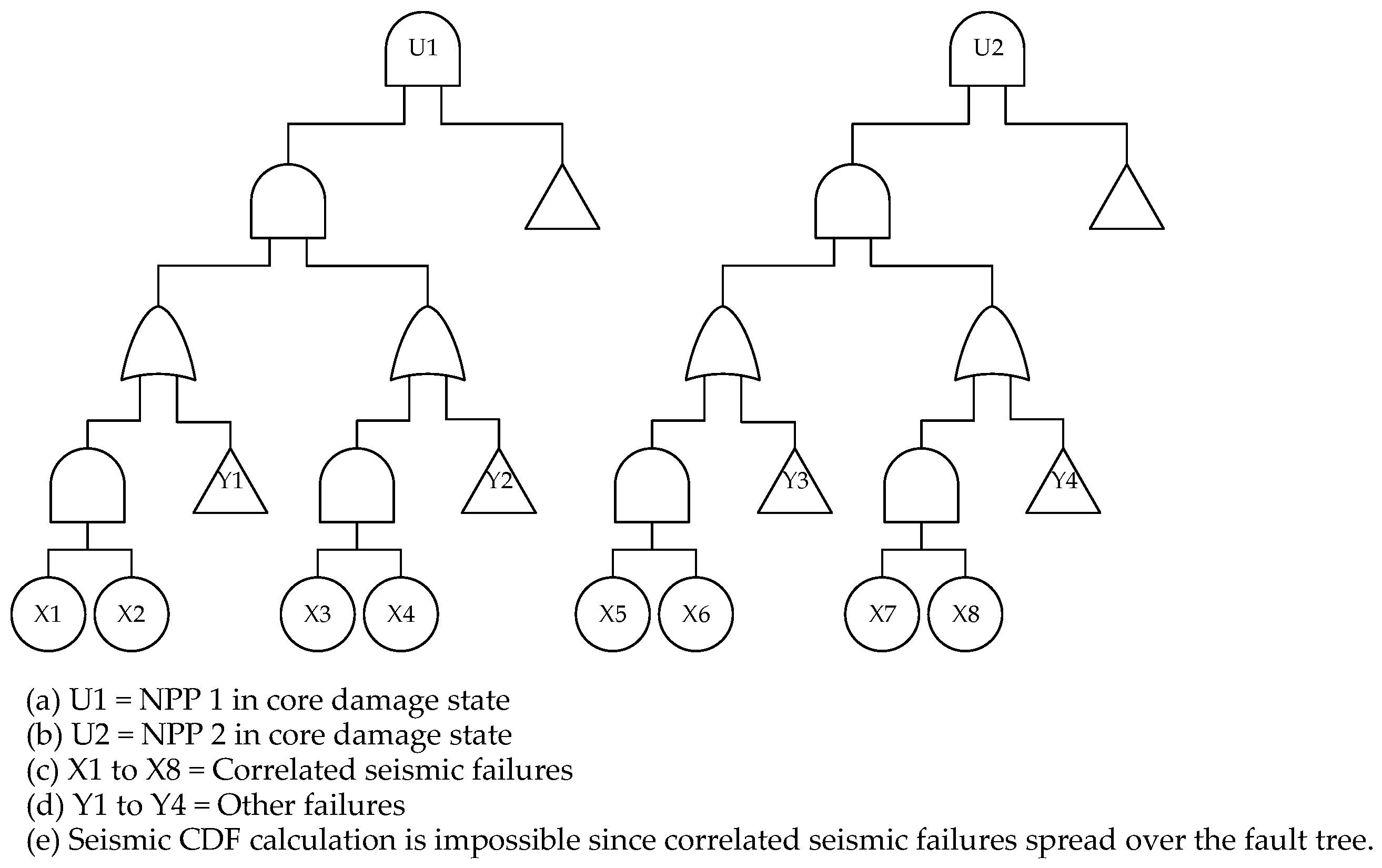




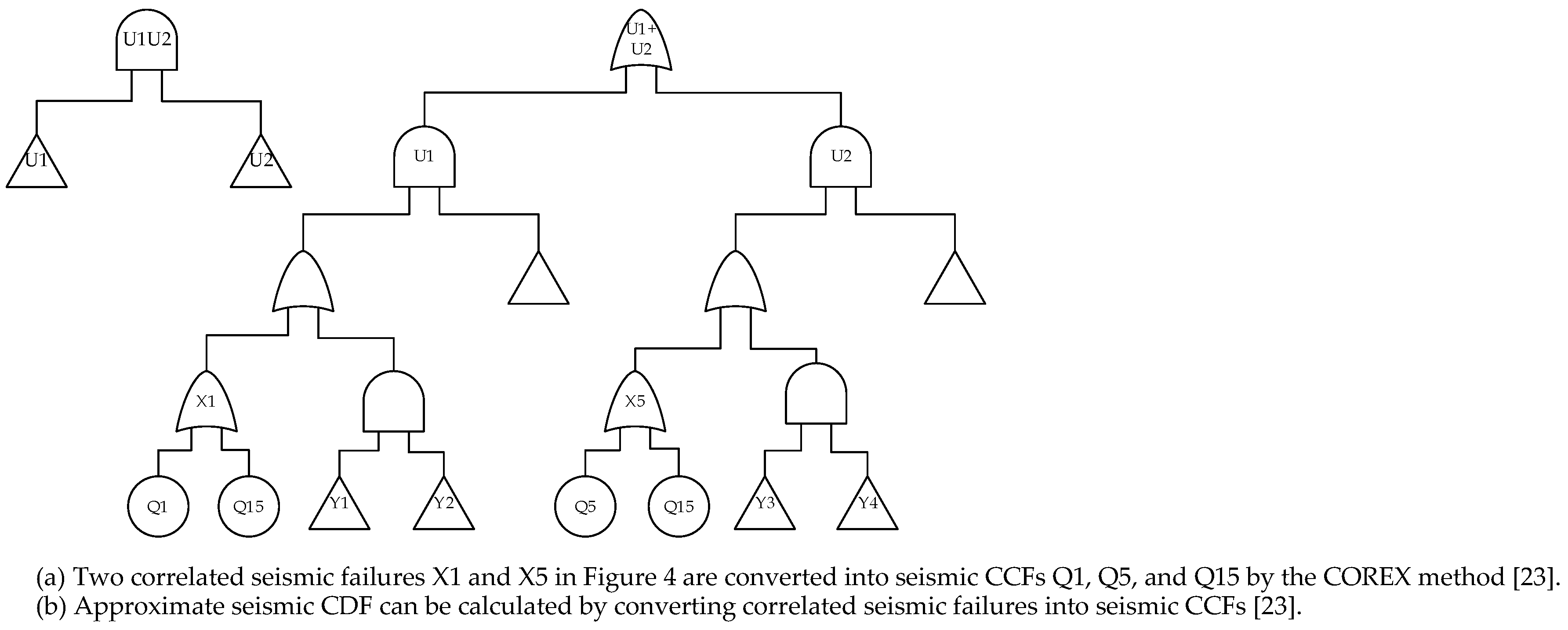




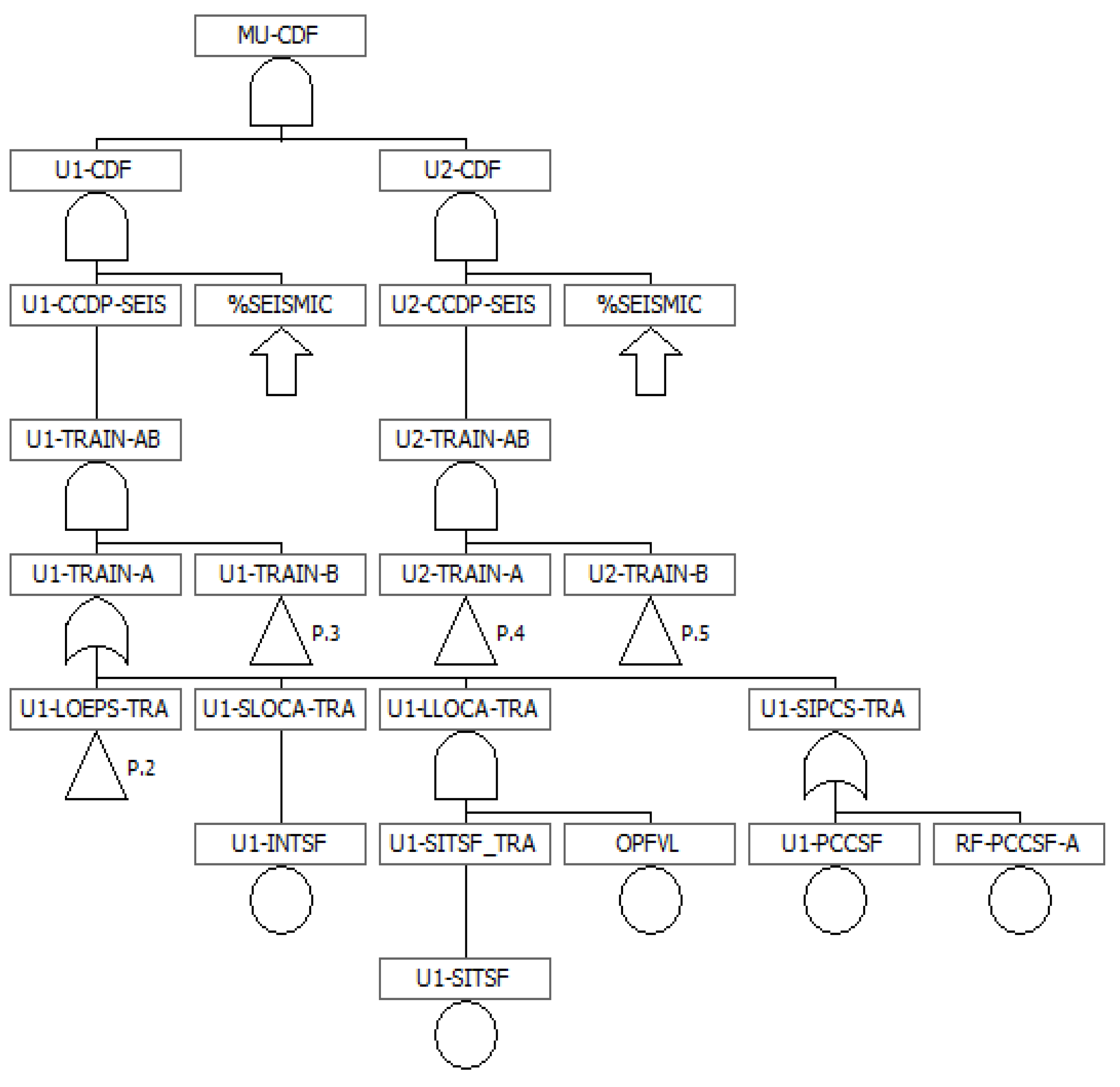



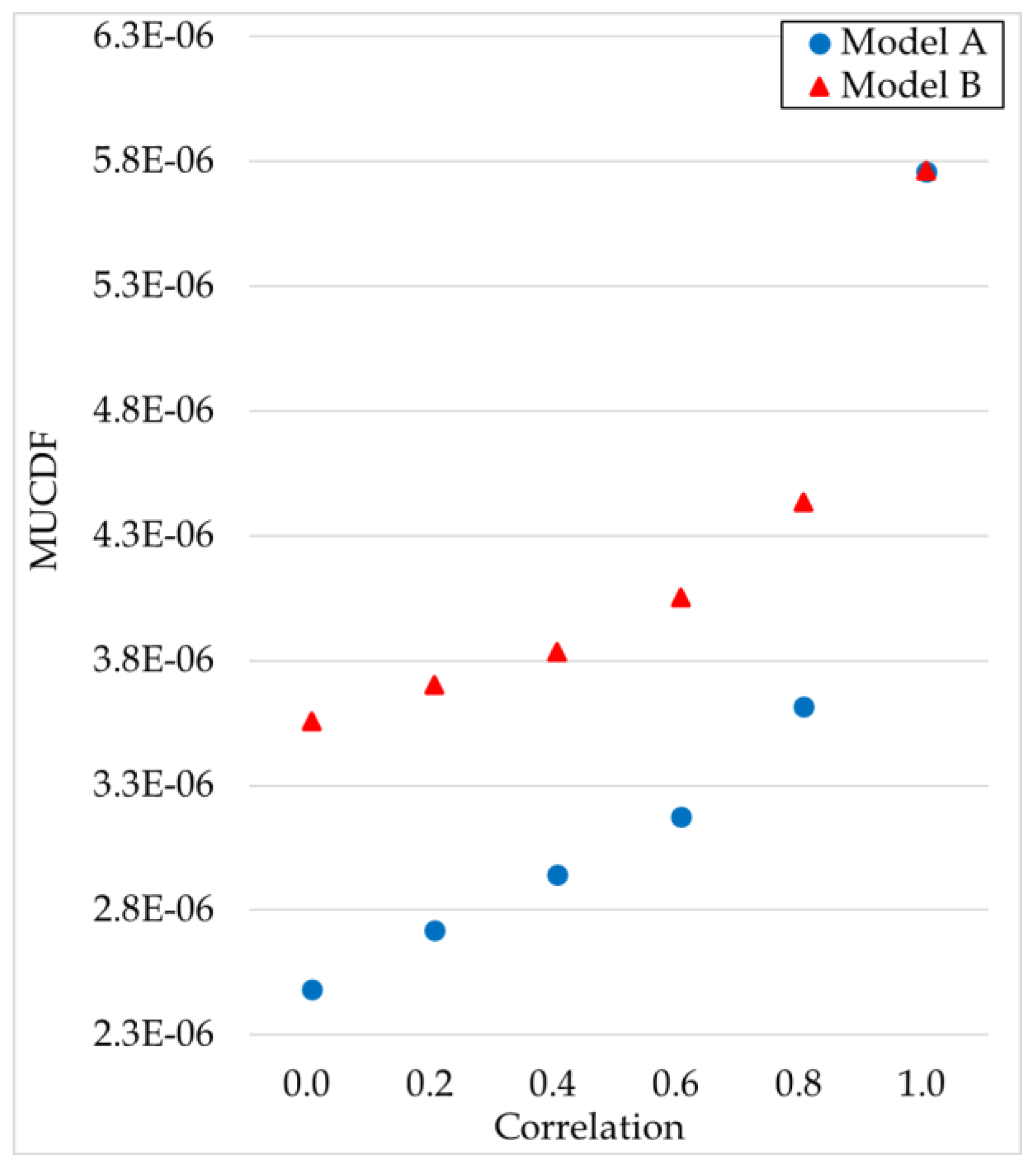




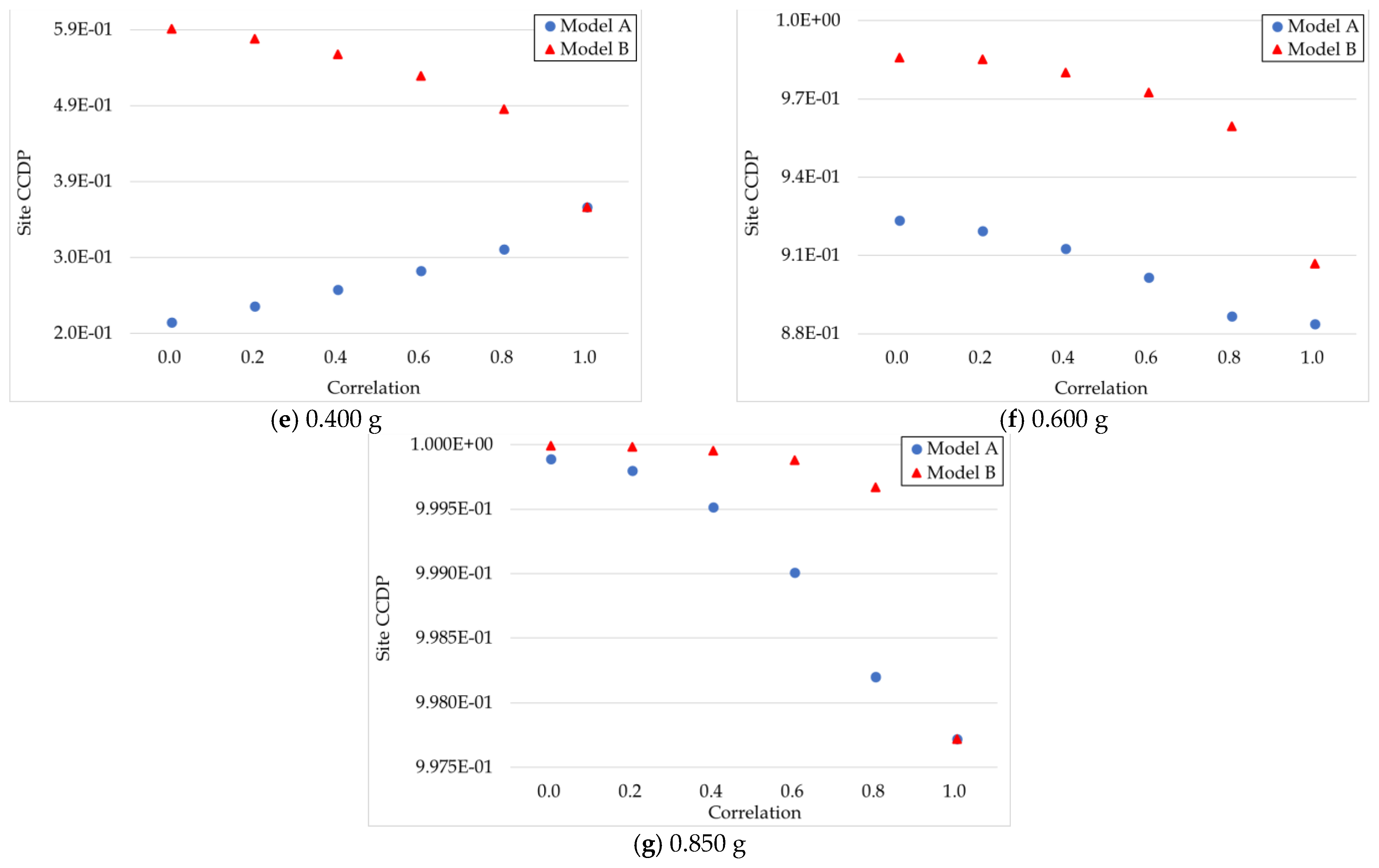
| Method | Applicability | Assumption | Seismic CDF |
|---|---|---|---|
| Traditional seismic SUPSA | MVN integration [23] is possible only when all correlated seismic failures exist under the single gate. | Correlated seismic failures are replaced with one seismic failure by assuming a full correlation among correlated seismic failures (see Figure 3). | Approximate |
| COREX method [23] | COREX method is always applicable even when correlated seismic failures spread over a fault tree. | Correlated seismic failures are converted into seismic CCFs without any assumption. | Best estimate |
| Event Tree Heading | Seismic Failures | Random Failures | Human Failures | Total Failures |
|---|---|---|---|---|
| LOEPS | 24 | 20 (a) | 2 (b) | 46 |
| SLOCA | 1 | N/A (c) | N/A | 1 |
| LLOCA | 4 | N/A | N/A | 4 |
| LOPCS | 4 | N/A | N/A | 4 |
| Model A | Model B | Failure Mode | Component | |
|---|---|---|---|---|
| Train A | Train B | |||
| EDGSF_A | EDGSF_B | EDGSF | Concrete coning | Emergency diesel generator |
| MVSSF_A | MVSSF_B | MVSSF | Structural | 4.16 kV switchgear |
| MVFSF_A | MVFSF_B | MVFSF | Functional | |
| MCCSF_A | MCCSF_B | MCCSF | Structural | 480 V AC load center |
| LVSSF_A | LVSSF_B | LVSSF | Structural | 480 V AC motor control center |
| LVFSF_A | LVFSF_B | LVFSF | Functional | |
| DCCSF_A DCCSF_C | DCCSF_B DCCSF_D | DCCSF | Structural | 125 V DC control center |
| BCHSF_A BCHSF_C | BCHSF_B BCHSF_D | BCHSF | Structural | Battery charger |
| SITSF_A SITSF_C | SITSF_B SITSF_D | SITSF | Concrete coning | Safety injection tank |
| INFSF_A INFSF_C | INFSF_B INFSF_D | INFSF | Structural | Inverter |
| PCCSF_A | PCCSF_B | PCCSF | Structural | Plant control cabinet |
| Model A | Model B | ||||
|---|---|---|---|---|---|
| Unit 1 | Unit 2 | Unit 1 | Unit 2 | ||
| Train A | Train B | Train A | Train B | ||
| U1-EDGSF_A | U1-EDGSF_B | U2-EDGSF_A | U2-EDGSF_B | U1-EDGSF | U2-EDGSF |
| U1-MVSSF_A | U1-MVSSF_B | U2-MVSSF_A | U2-MVSSF_B | U1-MVSSF | U2-MVSSF |
| U1-MVFSF_A | U1-MVFSF_B | U2-MVFSF_A | U2-MVFSF_B | U1-MVFSF | U2-MVFSF |
| U1-MCCSF_A | U1-MCCSF_B | U2-MCCSF_A | U2-MCCSF_B | U1-MCCSF | U2-MCCSF |
| U1-LVSSF_A | U1-LVSSF_B | U2-LVSSF_A | U2-LVSSF_B | U1-LVSSF | U2-LVSSF |
| U1-LVFSF_A | U1-LVFSF_B | U2-LVFSF_A | U2-LVFSF_B | U1-LVFSF | U2-LVFSF |
| U1-DCCSF_A U1-DCCSF_C | U1-DCCSF_B U1-DCCSF_D | U2-DCCSF_A U2-DCCSF_C | U2-DCCSF_B U2-DCCSF_D | U1-DCCSF | U2-DCCSF |
| U1-BCHSF_A U1-BCHSF_C | U1-BCHSF_B U1-BCHSF_D | U2-BCHSF_A U2-BCHSF_C | U2-BCHSF_B U2-BCHSF_D | U1-BCHSF | U2-BCHSF |
| U1-SITSF_A U1-SITSF_C | U1-SITSF_B U1-SITSF_D | U2-SITSF_A U2-SITSF_C | U2-SITSF_B U2-SITSF_D | U1-SITSF | U2-SITSF |
| U1-INFSF_A U1-INFSF_C | U1-INFSF_B U1-INFSF_D | U2-INFSF_A U2-INFSF_C | U2-INFSF_B U2-INFSF_D | U1-INFSF | U2-INFSF |
| U1-PCCSF_A | U1-PCCSF_B | U2-PCCSF_A | U2-PCCSF_B | U1-PCCSF | U2-PCCSF |
| No. | Intervals |
Ground Acceleration | Mean Seismic Frequency |
|---|---|---|---|
| 1 | 0.10–0.15 | 0.125 | 3.770 × 10−4 |
| 2 | 0.15–0.20 | 0.175 | 6.910 × 10−5 |
| 3 | 0.20–0.25 | 0.225 | 2.100 × 10−5 |
| 4 | 0.25–0.30 | 0.275 | 8.150 × 10−6 |
| 5 | 0.30–0.50 | 0.400 | 3.650 × 10−6 |
| 6 | 0.50–0.70 | 0.600 | 2.340 × 10−6 |
| 7 | 0.70–1.00 | 0.850 | 1.237 × 10−6 |
| Event (a) | Component | Failure Mode | |||
|---|---|---|---|---|---|
| EDGSF | Emergency diesel generator | Structural | 1.00 | 0.34 | 0.19 |
| MVSSF | 4.16 kV SWGR | Structural | 0.88 | 0.33 | 0.33 |
| MVFSF | 4.16 kV SWGR | Functional | 0.59 | 0.29 | 0.29 |
| LVSSF | 480 V load center | Structural | 0.71 | 0.30 | 0.30 |
| LVFSF | 480 V load center | Functional | 1.06 | 0.34 | 0.34 |
| MCCSF | 480 V motor control center | Structural | 1.48 | 0.34 | 0.34 |
| DCCSF | 125 V DC control center | Structural | 1.16 | 0.29 | 0.32 |
| BCHSF | Battery charger | Concrete coning | 1.35 | 0.29 | 0.32 |
| SITSF | Safety injection tank | Structural | 1.09 | 0.36 | 0.35 |
| INFSF | Inverter | Structural | 1.45 | 0.34 | 0.33 |
| INTSF | Instrumentation tube (primary system) | Piping break | 1.50 | 0.30 | 0.30 |
Publisher’s Note: MDPI stays neutral with regard to jurisdictional claims in published maps and institutional affiliations. |
© 2021 by the authors. Licensee MDPI, Basel, Switzerland. This article is an open access article distributed under the terms and conditions of the Creative Commons Attribution (CC BY) license (https://creativecommons.org/licenses/by/4.0/).
Share and Cite
Choi, G.G.; Jung, W.S.; Park, S.K. Sensitivity Study on the Correlation Level of Seismic Failures in Seismic Probabilistic Safety Assessments. Energies 2021, 14, 2955. https://doi.org/10.3390/en14102955
Choi GG, Jung WS, Park SK. Sensitivity Study on the Correlation Level of Seismic Failures in Seismic Probabilistic Safety Assessments. Energies. 2021; 14(10):2955. https://doi.org/10.3390/en14102955
Chicago/Turabian StyleChoi, Geon Gyu, Woo Sik Jung, and Seong Kyu Park. 2021. "Sensitivity Study on the Correlation Level of Seismic Failures in Seismic Probabilistic Safety Assessments" Energies 14, no. 10: 2955. https://doi.org/10.3390/en14102955
APA StyleChoi, G. G., Jung, W. S., & Park, S. K. (2021). Sensitivity Study on the Correlation Level of Seismic Failures in Seismic Probabilistic Safety Assessments. Energies, 14(10), 2955. https://doi.org/10.3390/en14102955





